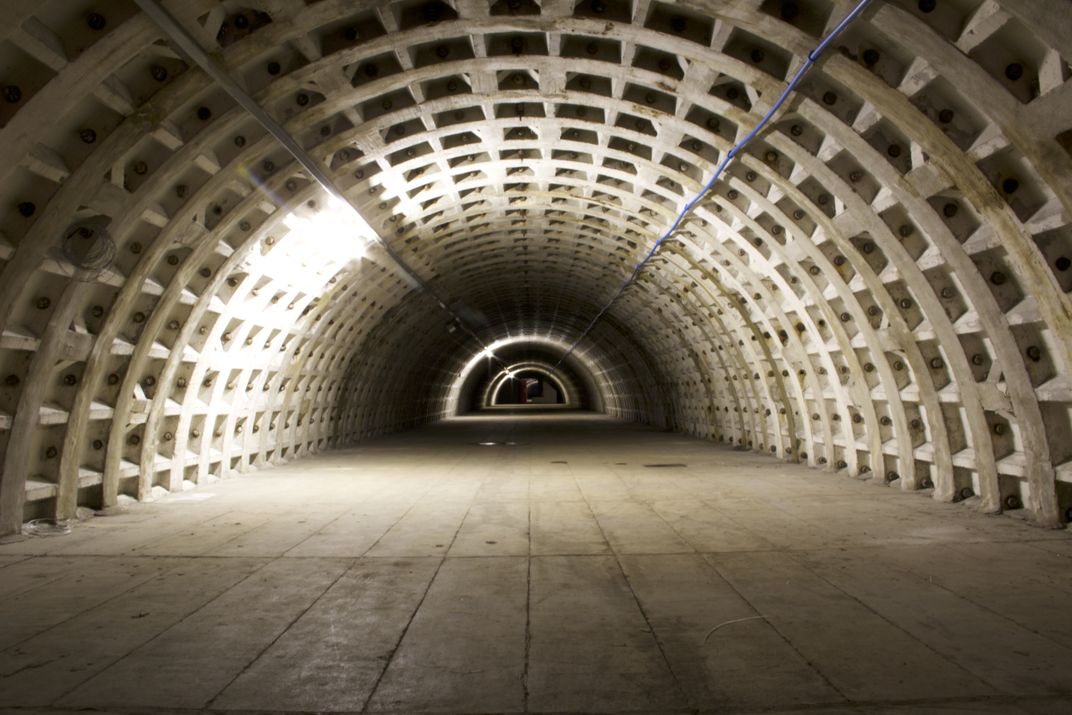Would You Eat a Salad Grown in a Bomb Shelter?
In London’s old, abandoned bomb shelters, a local food movement is taking root
/https://tf-cmsv2-smithsonianmag-media.s3.amazonaws.com/filer/e4/9b/e49b69ed-d855-455b-8497-533ba5f6c9c7/zero_carbon_food_lead_pic.jpg)
During World War II, German bomb raids sent London residents racing down narrow staircases into underground bomb shelters to avoid the destruction. After the war, the underground shelters sat unused, dark and damp, empty or holding rows and rows of legal and financial documents. These days, one of the eight shelters has a very different use: an urban farm, which despite being underground (and thus cut off from sunlight) is churning out high-quality microgreens and lettuce for the London market.
Like other seemingly insane ideas, the plan to grow food underground began at a bar, when Zero Carbon Food founders Steven Dring and Richard Ballard would sit and argue about the future of cities. Ballard was studying film and working on a piece about the future of cities--would the most important problem to solve for urbanizing areas be the democratization of energy? Would it be about food supply? Or would it be about resource scarcity, the plight of too little to give to too many people? Ballard ended up focusing his work on the supply of energy, but the underlying interest in the other areas remained. One day, during their pub debates, the question was asked: If cities keep expanding, how are we going to feed everyone?
Ballard and Dring found the concept of vertical farms--cultivation within a vertically inclined structure, like a skyscraper--a fascinating solution to this connundrum. But after going through some rough calculations, the idea fell short. Heading back to the drawing board, Dring and Ballard thought about London's abandoned bomb shelters, hundreds of meters of empty real estate slumbering beneath the clamor of city traffic. Ballard was familiar with these underground spaces from earlier film projects he had worked on. Suddenly, they had an idea. They spent time doing market and technology research, wondering if it would be possible to build a farm in these forgotten tunnels. Eventually, they worked with a horticulturalist and hydroponics expert that gave them a very important piece of advice.
"'You know, if it’s ever going to work, you need to get down there and start growing,'" Dring recalls the expert telling them. "So we went to Transport for London, and essentially they just gave us the keys."

Using hydroponics and LED technology, Dring and Ballard have succeeded in growing micro greens (greens in between a baby green and a sprout) and salad greens in the tunnels. The technology, though seemingly complicated, is actually quite simple: LED lights can be used to recreate a spectrum of light, basically creating a virtual sun. As for water and soil, hydroponics—growing produce using water and mineral nutrients but no soil—presents a clean solution.
A bench is set up with a trough in the middle about six inches deep. At the bottom of the trough runs a substrate, a hemp-like mat onto which seeds are sown. Every 12 hours or so, water redampens the mat. The seedlings stay in darkness for around five days, allowing them to propogate. Once that happens, the LEDs are switched on, and within three days, micro herbs are ready for harvest.
/https://tf-cmsv2-smithsonianmag-media.s3.amazonaws.com/filer/ac/33/ac337848-174c-447c-aa79-eb8d7f7d0d5e/zero_carbon_food_lettuce_close_up.jpg)
The company's name, Zero Carbon Food, suggests complete carbon-neutrality in the creation of this produce. But growing food underground—especially with the LED technology—uses energy. So how does the company create net-zero in terms of their carbon output?
"All of our energy comes from a green energy company that generates their energy through wind," Dring explains. Moreover, if the company does have a positive carbon output, they work to rectify that internally. Most discussion centers around offsetting carbon output (a rudimentary way of doing this would be to plant trees to offset a carbon footprint, though other technologies exist). Dring and Ballard didn't feel as though offsetting technologies were robust enough, so they are trying to inset, which means taking responsibility to generate their own renewable energy, which is then pumped back onto the grid.
So far, Zero Carbon Food has been met with approval by the market—especially those chefs who might eventually use the produce in their restaurants. Dring and Ballard have partnered with Michel Roux Jr., a two Michelin star chef, to assure quality of taste in their product. Before sampling the product, Dring says, Roux was skeptical. After, he was astounded by the quality.
"When I first met these guys I thought they were absolutely crazy, but when I visited the tunnels and sampled the delicious produce they are already growing down there I was blown away," Roux told The Independent.
The flavors aren't the only thing the produce has going for it: it's nutritionally equal to more traditionally grown greens, and completely safe to eat—Dring and Ballard made sure of that by sending the produce to labs to be tested for heavy metals and other dangerous particles that may have been present in the plants.
Buyers don't have to pay a premium for the produce, either. "We’ve been working closely with the marketers, and the wholesale price can give us a significant return for our investors," Dring explains. "Our prices stack up to a point where we don’t need to charge a premium."
/https://tf-cmsv2-smithsonianmag-media.s3.amazonaws.com/filer/4e/ec/4eecd077-5329-4247-aa63-cf0a2b6d42cf/zero_carbon_food_broccoli_microgreen.jpg)
If the LED and hydroponic technology seems like a lot of trouble for some micro greens, it's trouble that Dring truly believes is worth it.
"If you look at population movements, figures coming from the OECD and the United Nations, we’re seeing a migration from the rural environment to a more urban environment. London is due to grow in the next ten years by 2 million people," he says. "If we continue to see the same population growth that we’re experiencing at the moment, and people continue with the same carnivorous diets, then we will run out of arable land: it’s as simple as that. It’s just about complementing farming; [this technology] won’t ever replace farming, but it’s complementary to that."
/https://tf-cmsv2-smithsonianmag-media.s3.amazonaws.com/accounts/headshot/natasha-geiling-240.jpg)
/https://tf-cmsv2-smithsonianmag-media.s3.amazonaws.com/accounts/headshot/natasha-geiling-240.jpg)